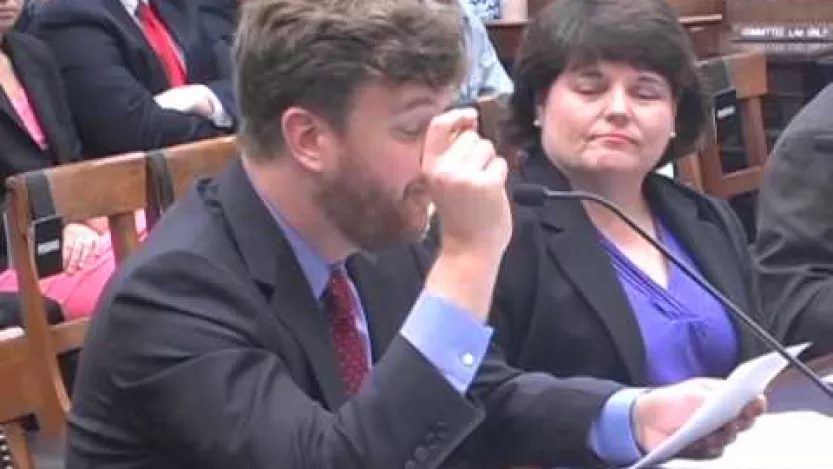Table of Contents
Greg Lukianoff opening remarks before House Judiciary Committee, June 2, 2015

If you had told me before I started working at the Foundation for Individual Rights in Education, the leading defender of free speech rights on college campuses, that I would routinely battle the startling misapplications of harassment codes to punish speech that is clearly protected by the First Amendment, I probably wouldn’t have believed you.
But when I began work at FIRE in 2001, I quickly discovered that not only were harassment codes routinely abused, but that leaders of the campus speech codes movement of the 1980s and ’90s explicitly argued that harassment codes should be used to punish speech they deemed offensive. I discovered that every single speech code that was overturned between 1989 and 1995 involved some attempt to twist a harassment code into a vague and broad tool against disfavored speech.

The proponents of harassment-based speech codes have quietly achieved tremendous success, despite the fact that courts have consistently recognized that merely labeling a speech code a “harassment policy” does not magically inoculate it from First Amendment scrutiny. Since 1989, at least 37 lawsuits have been filed challenging speech codes, over half of which involved overbroad harassment codes. Despite loss after loss in court, 58% of public colleges bound by the First Amendment maintain unconstitutional speech codes today. A substantial portion of these are harassment-based codes.
FIRE has seen harassment-based speech codes abused to punish obviously protected speech at dozens of universities around the country, including Tufts University, University of Colorado-Boulder, University of Denver, Appalachian State University, and more. Indeed, I wrote a book that deals extensively with the abuse of harassment codes, Unlearning Liberty.
Universities have long tried to claim that “the federal government made me do it” by citing Title IX and the requirements of the Office for Civil Rights of the Department of Education. This blame game became so ridiculous that in 2003, OCR issued a “Dear Colleague” letter to every university in the country spelling out that the federal government was not mandating — indeed, could not mandate — the adoption of campus harassment codes that violate First Amendment norms. After 2003, universities could no longer argue that they were being forced by the executive branch to maintain speech codes.
But in 2013, in response to the University of Montana’s mishandling of sexual assault cases, the Department of Justice and OCR issued a resolution agreement they deemed a “blueprint” for every college in the country. Shockingly, the blueprint’s definition of sexual harassment was even broader than the speech codes repeatedly struck down in federal court over the past 25 years.
For context, in 1999 the Supreme Court decided Davis v. Monroe County Board of Education, involving student-on-student harassment in the K-12 setting. The Court was very aware that the standard for harassment must be clear and rigorous in order to prevent creating an all-purpose tool to punish disagreeable speech.
The Court ruled that for an institution to be liable under Title IX for inadequately responding to harassment, the plaintiff must prove that the institution was “deliberately indifferent” to claims of sexual harassment, and that the targeted conduct was “so severe, pervasive, and objectively offensive” that the victim was “effectively denied equal access to an institution’s resources and opportunities.”
The Davis standard is rigorous precisely because the Supreme Court knew they had to protect First Amendment rights.
In the “blueprint,” however, OCR ignored these crucial limitations, explicitly overruling Montana’s “reasonable person” standard. Under the blueprint, universities must investigate harassment claims even when a reasonable person would not have found the speech objectionable, thereby weaponizing the sensitivities of the least speech-tolerant students of campus.
In sharp contrast to Davis, the blueprint definition of harassment was simply “unwelcome verbal conduct [a.k.a. speech] of a sexual nature.” Such a vague, broad standard would never hold up in court, yet OCR sought to impose it nationwide. Understand that all harassment regulations and guidance coming from OCR are applied by universities to a litany of categories including race, ethnicity, religion, and even “political viewpoint.” So as a practical matter, the blueprint would be understood by risk-averse general counsels as notice that the federal government was now defining harassment as “any speech that offends, even if a reasonable person would not have been offended.”
In the face of public outrage, OCR eventually gave some indication that it is backing away from this unconstitutional standard. Assistant Secretary for Civil Rights Catherine Lhamon wrote FIRE reaffirming OCR’s commitment to the First Amendment and characterizing the blueprint as “the resolution of that particular case and not OCR or DOJ policy.”
Unfortunately, Department of Justice officials continue to publicly praise the Montana agreement as a model for other universities to follow. Universities are effectively being told: “Pass this unconstitutional speech code or risk losing federal funding.” Universities are not willing to risk running afoul of OCR, and so many of them are passing unconstitutional codes that adopt the blueprint’s harassment standard.
Troublingly, the legislative branch has followed suit. Senator McCaskill has recently suggested legislation to counter the Davis standard. And Congress is considering the Tyler Clementi Higher Education Anti-Harassment Act, which in its present form, threatens the First Amendment by failing to track Davis.
Harassment codes have been abused for too long, chilling campus speech and trivializing real harassment. The Supreme Court has supplied a careful, speech-protective standard. Congress can settle this debate easily by clarifying that the Davis standard is the definition of peer harassment under federal anti-discrimination standards. By taking this step, Congress could end a decades-long attempt by some administrators and, sadly, a federal agency to turn harassment into an all-purpose campus speech code.
We hope that the United States Commission on Civil Rights will help add clarity to the law and protect free speech on campus.
Thank you.

